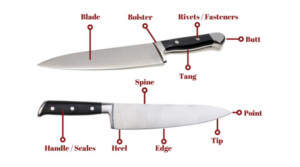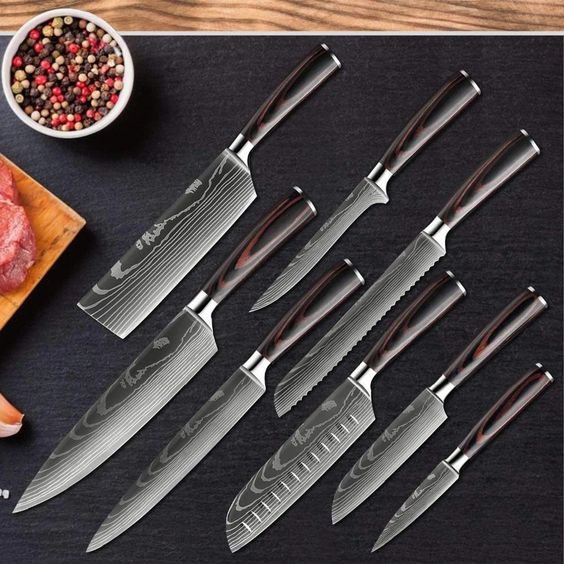When you have the correct equipment, preparing food is easier, faster, and safer, but with so many different types of knives on the market, selecting one that meets your needs can be difficult. It’s all too easy to buy a bunch of specialty knives you’ll never use if you don’t have the right information, which means you’ll end up with a bunch of useless knives in the back of your utensil drawer.
The different parts of a knife: Anatomy of a kitchen knife
Point: The blade’s most extreme point. This knife is frequently sharpened to a fine point and can be used to puncture or score food.
Blade: The blade refers to the part of the knife that is utilized for cutting. It’s commonly made of steel, but it could also be made of ceramic, titanium, or even plastic.
Edge: This is the sharpened portion of the blade that does the majority of the cutting. The fineness with which the knife’s edge is ground determines its sharpness, which is determined by both the knife’s quality and how often it is sharpened. It can either be serrated (like bread knives) or straight.
Tip: The tip is the front half of the knife’s edge, right beneath the point. It’s the section of the blade that’s employed for delicate chopping and cutting.
Spine: The Spine is the blunt section of the blade opposite the edge. The blade’s thickness provides strength. It gives the knife a sense of balance. A thicker spine means a more powerful blade!
Heel: The heel is the blade’s lowest edge, closest to the bolster and furthest from the tip. It’s usually the blade’s broadest portion. When the chef needs greater strength or pressure to cut through thicker or tougher meals, this area of the edge is most usually used.
Tang: It’s the blade’s unsharpened part that connects the handle to the blade edge. It provides the knife with the essential weight, balance, strength, and stability. The best knives are full-tang [one that runs from the blade’s one end to the butt].
Handle or scales: The handle, often known as the ‘scales,’ is the part of the knife that the chef grips while using it. It comes in a variety of materials and can be straight or have finger grooves and other ergonomic characteristics to make it easier to grip. Some knife makers will forego the handle entirely, opting instead to make a knife out of a single piece of steel with the tang serving as a handle.
Bolster: Between the handle and the blade, there is a raised area. It creates a little gap between the blade and the user’s hand to prevent the finger from slipping onto the blade while cutting.
Handle fasteners, or rivets: The rivets or screws that secure the handle pieces to the tang are known as tang rivets or tang screws. In less expensive designs, the handle may be attached to the tang with resin or epoxy instead of rivets.
Butt: It’s the bottom of the knife and the end of the handle.

Different Types of knives you must know about
- Chef’s Knives
Chef’s knives are the most popular sort of knife that most of us are familiar with. This knife has been seen in a lot of cooking shows and reality shows. As the name implies, the Chef uses this all-purpose knife to cut a variety of vegetables, meats, and other foods.
- Cleaver
The ‘Butcher’s knife’ is another name for it. Its shape is rectangular and flat. They are the broadest and heaviest knives in the collection, with a hone along the blade’s spine for hanging. It is advantageous to cut meat.
The large front blade of a cleaver distinguishes it from other knives. A thin handle and a large rectangular blade are typical features. Cleaver is a tool that is used to slice huge portions of meat before they are cooked. Large vegetables and fruits such as pumpkin, melon, and watermelon can also be sliced with a cleaver.
- Bread knife
A bread knife is used to cut bread slices, as the name implies. If you buy bread in the form of a loaf, you can cut it into appropriate thickness slices with a bread knife. If you try to cut a bread loaf with a conventional knife, you may wind up with uneven slices, but bread cutting with a bread knife is a breeze.
Cakes with soft, fluffy textures can also be sliced using bread knives, as they can cut through them without knocking the air out of the sponge or harming the overall shape. If you don’t have a cake leveler, a bread knife can be used to even out your sponge cakes after baking if you don’t have one.
- Steak knife
A steak knife is used to cut cooked meat in a precise manner. The zig-zag blade on this knife aids in the effective chopping of meat. Because meat has a chewy texture, cutting it with an ordinary knife might be a bit messy, therefore a steak knife is an ideal option.
- Fillet knife
This knife is mostly used to cut fish fillets, as the name implies. A fillet knife is a long, thin knife that is used to cut fish with accuracy. A fillet knife is so flexible that you can literally blend its blade with your hands, which is a delightful fact to know. The sharply pointed tip makes it easy to cut through fish skin and extract the intricate bone without crushing the delicate flesh surrounding it.
- Utility Knife
The shape of a utility knife is similar to that of a chef knife, although it is smaller and slimmer. Smaller foods and vegetables, such as shallots, can be chopped with a utility knife. It has many of the same characteristics as a chef knife, but it is more beneficial for cutting smaller food items since the utility knife allows for more precise cutting. When your cook’s knife isn’t quite up to the task, reach for a utility knife instead.
- Pizza cutter
If you order pizzas frequently, you should invest in a high-quality pizza cutter. A pizza cutter will aid in the appropriate cutting of pizza slices, as most pizzas delivered to your door do not have proper cuts. To acquire your ideal triangular piece, simply slide the cutter on the pizza 2-3 times.
Conclusion
Stainless steel is the ideal material for knives since it is rust and corrosion-resistant as well as sturdy. The blade is also stain-resistant, but because it is an alloy, make sure to inspect the quality. Make sure you purchase from reputable vendors. Jamboshop sells kitchen knives from reputable brands such as Brabantia and Rashnik, so you can be confident that the blades you buy are manufactured of high-quality alloy.


